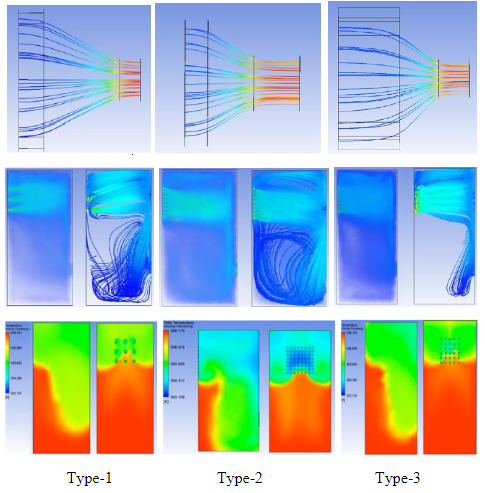Eco-cooler Analysis for Room Temperature Reduction
doi: 10.14456/mijet.2020.15
Keywords:
Eco-cooler, Computational Fluid Dynamics, Room Temperature ReductionAbstract
This study was to examine reducing a 4.2×3.1×3.3 m3 room temperature by an Eco-cooler instead of using electric energy. The Computational Fluid Dynamics (CFD) program was used to test the effect of heat transfer and to predict the fluid flowing behavior so that the temperatures resulting from the Eco-cooler can be analyzed. In the experiment, the air velocity range was set between 1-3 m/s for comparison between the temperatures obtained from the actual experiment and those from the analysis by the CFD program. This study revealed that the results from the CFD program and the experimental results were very similar; thus, their discrepancy was between 0.01 – 2.37 % and the room temperature could be reduced by 1-3 degrees Celsius. In conclusion, reducing the room temperature depends on the air velocity and size of the Eco-cooler.
References
Chad, K.E. and Brown, M.M. (1995). Climatic stress in the workplace: its effect on thermoregulatory responses and muscle fatigue in female workers. Applied Ergonomics. 26(1) : 29-34.
Maiti R. (2008). Workload assessment in building construction related activities in India. Applied Ergonomic. 39 : 754-765.
Lundgren, Kownacki, K., Kuklane, K., Gao, C., and Holmér, I. (2013). Effects of Heat Stress on Working Populations when facing Climate Change. Industrial Health, 51(1) : 3-15. https://doi.org/10.2486/indhealth.2012- 0089.
Ashis, P., [Online]. Available at: https://observers.france24.com/en/20160602-bangladesh-air-conditioner-plastic-bottles-technology.
Akshansh, M., Anish, D. G., Amit, K. M., and Anand, S., (2016). Zero Electricity Air Conditioning Using Phase Changing Materials. International journal of thermal engineering, 4(1) : 10–14.
Popovici, C. G., (2017), HVAC System Functionality Simulation Using ANSYS-Fluent [J]. Energy Procedia, 112 : 360-365.
Fang P, Liu T, Liu K, et al. (2016), A Simulation Model to Calculate Temperature Distribution of an Air-Conditioned Room[C]. International Conference on Intelligent Human-Machine Systems and Cybernetics. IEEE, 2016.
Sonntag E., Borgnakke C., and Van Wylen J., (2003). Fundamentals of Thermodynamics, 6th Edition. John Wiley and Sons, USA.
Schwarz W, Marchal T. Innovation in Building Design through Engineering Simulation. ANSYS, Inc.; 2009.
ANSYS-Fluent, Theory Guide.

Downloads
Published
How to Cite
Issue
Section
License
Copyright (c) 2020 Mahasarakham International Journal of Engineering Technology

This work is licensed under a Creative Commons Attribution-NonCommercial-NoDerivatives 4.0 International License.








